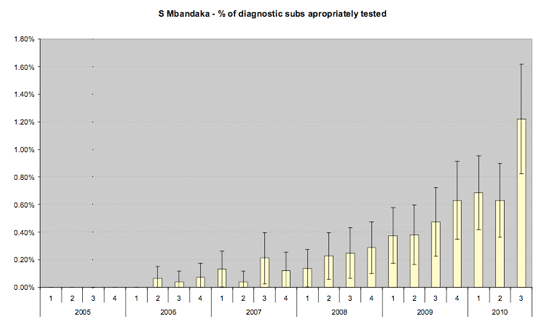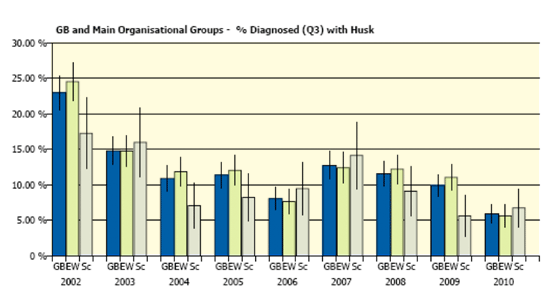



New And Emerging Cattle Threats In The UK
The third quarterly report of emerging cattle threats in the UK cattle, produced by the Veterinary Laboratory Agency, identifies that suspected closantel toxicity was investigated for the first time in UK cattle.
Analysis of Diagnosis Not Reached (DNR) Overview
During July to September 2010, 27 per cent of cattle submissions were undiagnosed, the same as in the equivalent period in previous years. However, there was a statistically significant increase in undiagnosed submissions between the second and third quarter of 2010, from 24 to 27 per cent.
A statistically significant increase in undiagnosed diarrhoea and enteric disease was noted between Q2 and Q3 2010 but not between Q3 of 2010 and Q3 of 2009. The increase was in neonatal, pre-weaned and mixed aged groups. Both beef and dairy farms in the north of England and Western England were the principally involved.
There was also an increase in coccidiosis and salmonellosis, between the second and third quarters of 2010 but there was no increase in other common calf pathogens such as coronavirus, rotavirus or cryptosporidiosis. The figures for Q3 of 2010 were comparable with the equivalent time period in previous years.
A significant increase in a diagnosed disease may result in an increase in undiagnosed disease for various reasons e.g. tests are not 100 per cent sensitive.
There have been no reports of any known cause for this rise in undiagnosed samples. The VLA will carefully monitor enteric disease in young cattle over the coming quarters to determine if this finding is a one-off event or an emerging trend. If the latter, then further investigation of undiagnosed diarrhoea in the target population would be warranted. No other further action is currently recommended.
Anecdotal reports of an increase in undiagnosed respiratory disease in adult cattle were made by several VLA Regional Laboratories but the data showed no statistically significant increase using the current method of using 2 years of pooled data for comparison. However, a significant increase in England and Wales was seen when respiratory DNR were compared with the pooled equivalent for the previous 5 years.
The VLA will monitor respiratory disease in adult cattle over the coming quarters to determine if this finding is a one-off event or an emerging trend. If the latter, then further investigation of undiagnosed respiratory disease in the target population would be warranted. Initially this would be by attempting to increase the proportion of relevant cases that were examined by necropsy rather than through submission of postal samples: this is likely to increase the diagnostic rate and would allow for more comprehensive examinations into any potential new or emerging condition. No other further action is currently recommended.
ON-GOING NEW AND EMERGING DISEASE INVESTIGATIONS
During the second quarter of 2010, there was an increase in undiagnosed skin disease in adult cattle. An allergic-type syndrome, of unknown aetiology, was noted in most of these undiagnosed submissions. A histological investigation revealed eosinophilic dermatitis, which is probably due to a hypersensitivity reaction or to parasitic disease, or both. There was no evidence of besnoitiosis or parafilariaisis in the undiagnosed cattle, which are two current potential new disease risks to GB cattle. It should be noted that, this investigation alone is insufficient to rule out the presence of either parasite in GB. A report on these skin cases has been sent to Defra FFG. A protocol for investigation of similar cases has been written which will be implemented if further cases arise. No further cases were reported during the third quarter so the eosinophilic dermatitis cases of unknown aetiology may be sporadic, transient or seasonal.
In this quarter, a preliminary qualitative risk assessment of Parachlamydia emerging in the GB cattle population as a potential cause of bovine abortion was initiated. This was a response to first detection in Scotland in 2009 and reports in the scientific literature suggesting high prevalence in some countries. Parachlamydia is not believed to be recently introduced to GB, rather one that has not previously been tested for. Assessment of the risk of this infection to cattle health, welfare and production requires some knowledge of likely prevalence. This is not currently available as routine tests on bovine abortion for scanning surveillance do not include examination for Parachlamydia. However, relevant submissions are examined microscopically for Q fever and these tests have not revealed large numbers of submissions suggestive of Parachlamydia infection.
Bibersteinia trehalosi as a cause of bovine pneumonia and septiciaemia continues to be investigated, because scanning surveillance indicates that it is increasingly isolated from cattle. It is a recognised ovine and caprine, but not a, bovine pathogen. The VLA is collaborating with Glasgow University to determine if strains isolated from cattle constitute a distinct, cattle-specific population of B. trehalosi or if they are ovine/caprine strains that are also able to infect cattle.
Following the introduction of charges on 01/08/10 for the investigation of suspect cases of bovine neonatal pancytopenia (BNP) by post mortem, the number of carcases submitted showed a steep decline. Nonetheless anecdotal reports from private vets (PVSs) to VLA and SAC VIOs suggest that cases of BNP are continuing to occur. Many PVSs are now aware of and can recognise the condition and make a diagnosis on clinical grounds, without recourse to PM examination. However, the specificity of clinical diagnoses is probably poorer than those made through necropsy and histopathological examination. VLA is not systematically collecting information from PVS on the occurrence of BNP calves.
Initial results from an investigation study into post-calving endometritis in a dairy herd with high incidence of disease have been published (Cattle practice Vol 2, 2010). The Virology Department of the VLA is further characterising both bovine herpesvirus-4 and bovine lymphotrophic herpes (BLHV) viruses that were detected by the study, but their aetiological significance has not been determined.
This small, single-herd study may add to our understanding of the causes and predisposing factors for post-calving endometritis, a common disease in dairy cows. The application of epidemiological methods to a herd-level investigation has been educational and will benefit future Emerging Disease Investigations.
In October 2010, a half day session at the British Cattle Veterinary Association Annual Congress was devoted to scanning surveillance and the findings of some recent Emerging Diseases Investigations were presented. These included: bovine neonatal pancytopenia, B. trehalosi infection of cattle, unusual post-calving endometritis and parachlamydiosis, as well as reviews of scanning and syndromic surveillance for cattle diseases. These have been published in Cattle Practice vol 18 part 2, October 2010.
UNUSUAL DIAGNOSES
In July 2010, unusual brain lesions were detected in an individual Simmental heifer with a history of ataxia and prominent sweating. When examined by the private veterinary surgeon, it was standing still with its head down, its eyes half closed and there was reddening and ulceration of the skin of the nares. The heifer became recumbent and died the following evening. The gross and histological lesions were unlike those occurring in the recognized nervous disorders of cattle, but were very similar to those associated with closantel toxicity in sheep.
The heifer was the only one affected out of approximately 70 cattle at grass that were treated with a product that contained closantel. The affected animal developed clinical signs approximately four days following administration of the recommended dose and all the animals were treated from the same container. No other treatments were given at the same time as the product containing closantel. Adverse reactions to closantel administration do not appear to have been previously reported in cattle. The Veterinary Medicines Directorate was notified of this suspected adverse reaction.
Figure 3: Quarterly incidents of S Mbandaka from 2005-2010

The Salmonella Emerging Disease Surveillance model showed more non-Typhimurium and Dublin salmonellae in September than expected according to historical data. Seventeen out of 29 incidents involved S. Mbandaka which has been increasingly implicated in farm incidents over the past 5 years (fig. 3). Further analysis of data indicated that submissions originated mainly from the South West of England and was reported, predominantly in housed, adult dairy cattle. The submissions were submitted with a history of diarrhoea of low to moderate severity. S. Mbandaka is associated with feed, principally soya and rapeseed meal and appear to have increased in Q3, and in the past 4 years. The cause of this is not known and elucidation would require further study. At present the risk to the cattle industry and to public health is relatively low, S. Mbandaka is rarely isolated from humans and the increase in cattle diagnoses is not likely to result in more human cases of human salmonellosis. The situation will continue to be monitored, particularly the frequency and geographical distribution of diagnoses. If the risk is deemed to become significant and warrant additional intervention beyond current control measures and advice for the control of salmonellosis, Defra and stakeholders will be consulted.
Lungworm (dictyocaulosis) In England and Wales, there were large decreases in the number of scanning surveillance submissions for the diagnosis of lungworm and in the number of diagnoses actually made. The proportion of submissions tested that yielded a diagnosis of lungworm also fell significantly. However in Scotland, there was a non-statistically significant increase in these figures (Fig. 4).
The reasons for these changes are not readily apparent but may be related to relatively dry weather in the spring and early summer of 2010 in England and Wales.
Figure 4

The profitability of beef farming may be reducing further: the Agricultural Inflation Index, recorded by Anglian Farmers, shows a 9.3 per cent increase in beef production costs, compared to a 3.4 per cent increase in retail prices, from September 2009 to August 2010. The average cost of production of a weaned beef calf is now £2.73 per kilogram of live weight for lowland suckler herds, and £2.99 per kilogram for suckler herds in less favoured areas. This compares to the current average beef deadweight price of £2.70 per kilogram. Reduced margins could adversely affect the uptake of veterinary input into herd health planning, disease diagnosis and scanning surveillance.
High mortality in cattle transported long distances in late pregnancyInvestigations were undertaken at several VLA Regional Laboratories into the rapid deaths of pregnant heifers that had been imported from mainland Europe. The cause in all cases was severe ketosis/fatty liver arising from inadequate food intake to meet metabolic demands. The reasons for the former were suspected to be associated with the transportation and changes in diet before, during or after the journey. Import of pregnant dairy heifers has increased in recent years. There are associated risks to the health and welfare of animals transported long distances when pregnant, as well as to the biosecurity of recipient farms. In addition, transport when more than 90 per cent of gestation has elapsed is illegal. These issues were communicated to stakeholders and the veterinary profession by means of a Defra Customer Information Note and a letter to the Veterinary Record, published in November 2010.
Risk communicationA summary of scanning surveillance findings and current risks was presented to CHAWG; all had previously been presented to Defra.


